Mattresses are made of a series of layers that have specific benefits, from cushioning comfort to proper support. Understanding the materials used in the layers of a particular mattress can help you decide whether it’s a good fit for your body type and sleep style, which is the key to a restful night’s sleep.
Ahead, I’ll break down the different layers of a mattress and look at the benefits and drawbacks of popular materials.
What are the Layers in a Mattress?
Regardless of whether a mattress contains coils or is made entirely out of foam, its layers can generally be broken down into the following:
- Cover. The cover protects the mattress interior, helps regulate its temperature, wicks away moisture, and repels allergens and dust mites. Some mattresses have cushioning materials quilted into the cover for softness and comfort.
- Comfort Layer. The comfort layers in a mattress are its uppermost layers. These layers are made with materials that add cushioning, help relieve pressure, dampen motion transfer and manage temperature.
- Transition Layer. The transition layer is situated below the comfort layers and above the support layers. It helps prevent the body from sinking through the softer comfort layers into the firmer support layer below by adding stability, support, and durability.
- Support Layer. In the support layer, which is located at the base of the mattress, materials like high-density foams or coils stabilize the layers above and help sleepers maintain the proper spinal alignment.
Mattress Covers
Mattress covers come in a variety of materials, all of which offer specific benefits. The most popular materials include cotton, which is known for its breathability, and synthetics, which are designed to wick away heat and moisture.
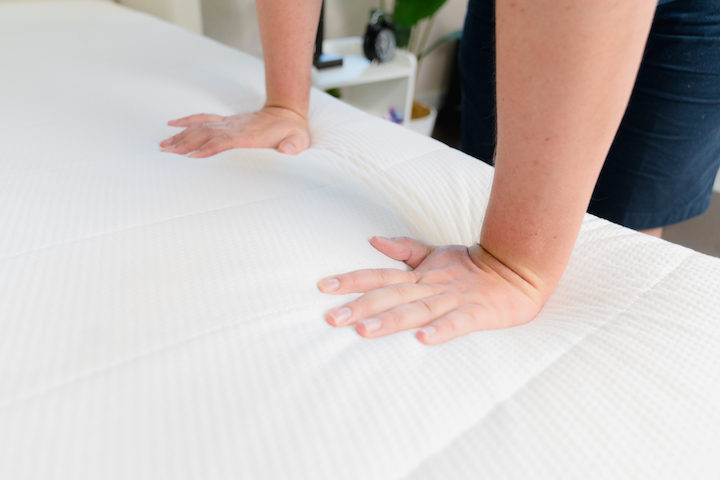
Cooling Covers
Phase Change Material
People who wake feeling excessively hot and sweaty benefit from mattress covers that incorporate phase change materials (PCM), which change from one to another depending on their temperature.
Since they can absorb and release a lot of energy to maintain a consistent temperature, they work especially well in a mattress. Essentially, PCMs absorb and store body heat released in the night. Then, when your body temperature drops and you cool down, PCMs release heat to help maintain a neutral temperature.
Proprietary Fabrics
Some brands offer their own special cover fabrics. The Helix Midnight Luxe, for example, comes with an optional GlacioTex cover. This hypoallergenic fabric is made with fibers that have a high thermal conductivity. Similar to PCMs, GlacioTex is designed to pull heat away from the body, so it’s a great fit for hot sleepers.
Cotton
Cotton is a popular material for soft, breathable mattress covers. The Saatva Classic is a great example. It’s made with an organic cotton cover that circulates air to minimize heat retention. But it’s not actively cooling like PCMs, so it’s best for sleepers who don’t have issues with overheating at night.
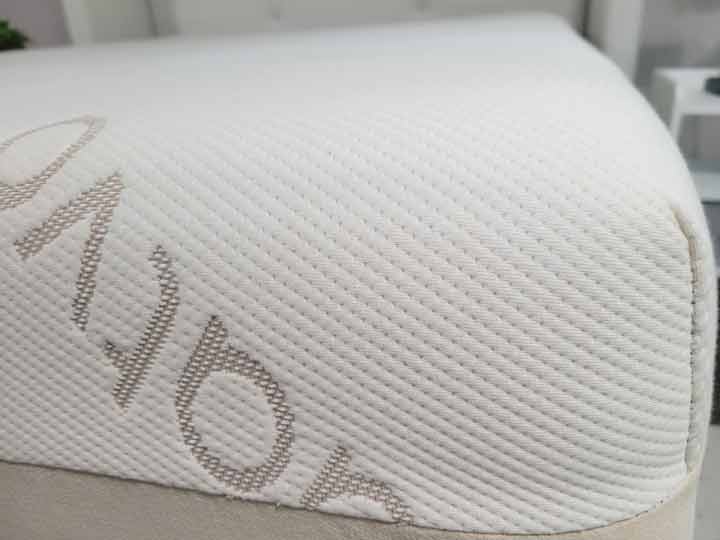
Cashmere
Cashmere is a luxurious material that adds softness to a mattress cover. DreamCloud uses a cashmere blend on all three of its mattresses for a luxurious, breathable feel.
Mattress Comfort Layers
The feel, temperature and pressure relief a mattress offers is dependent on its comfort layer. Some mattresses combine several materials into multiple comfort layers.
Tufted Pillow Tops
A tufted pillow top mattress incorporates an extra comfort layer into the very top of the mattress for a push, luxurious feel. Traditionally, pillow top mattresses were innerspring beds with a thin comfort layer sewn into the cover at the top. Most modern pillow top mattresses are actually hybrid mattresses with a more generous pillow top. If you’re looking for beds with a similar feel to traditional pillow tops, check out our list of the best innerspring mattresses.
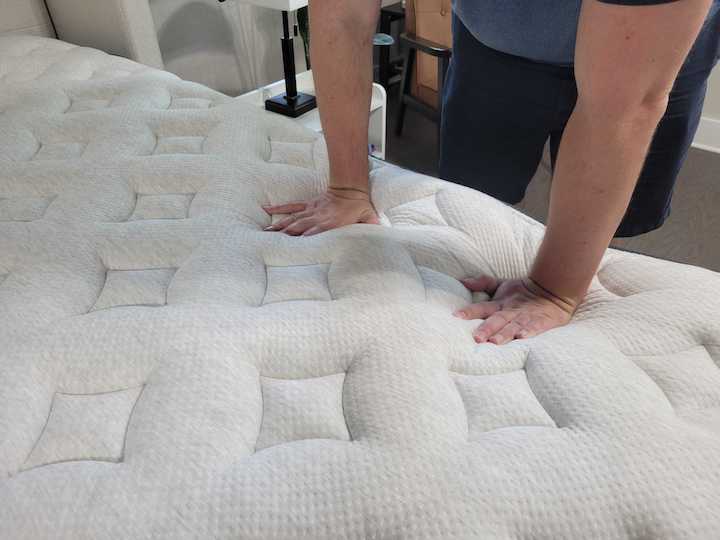
Memory Foam
Memory foam is a synthetic material that responds to heat and pressure to contour closely around the body’s curves. It allows for deep sinkage into the mattress, with a hugged sensation that distributes body weight well to relieve pressure points. Since memory foam can trap heat, it’s often infused with gel or copper or constructed with open cells to boost breathability.
TEMPUR is the proprietary memory foam used in TEMPUR-Pedic mattresses. It was originally developed for NASA, but was introduced to the public as a mattress material in 1992.
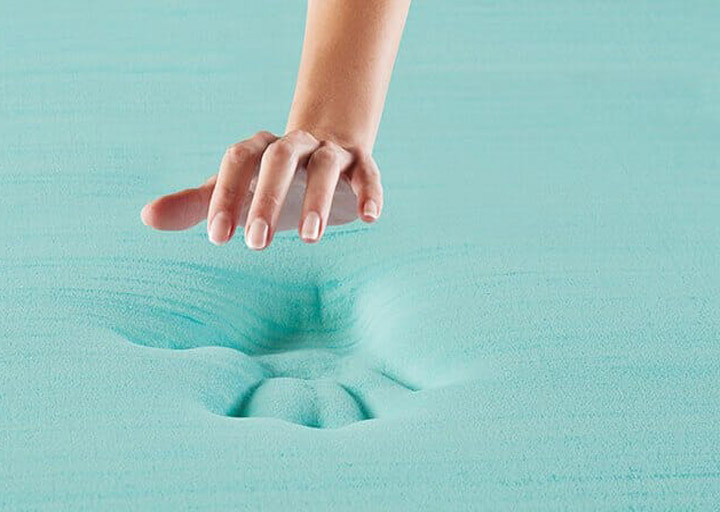
Latex
Natural latex is an eco-friendly material that offers a gently buoyant sensation. It lacks the sunken sensation of memory foam — you get the sensation that you’re “on top of” the mattress rather than “inside” it — but it offers comparable pressure relief. Latex is incredibly durable, but it can be expensive and it adds weight to a mattress. Nest Bedding uses latex in its popular Finch mattress and it’s also used in the Avocado Green.
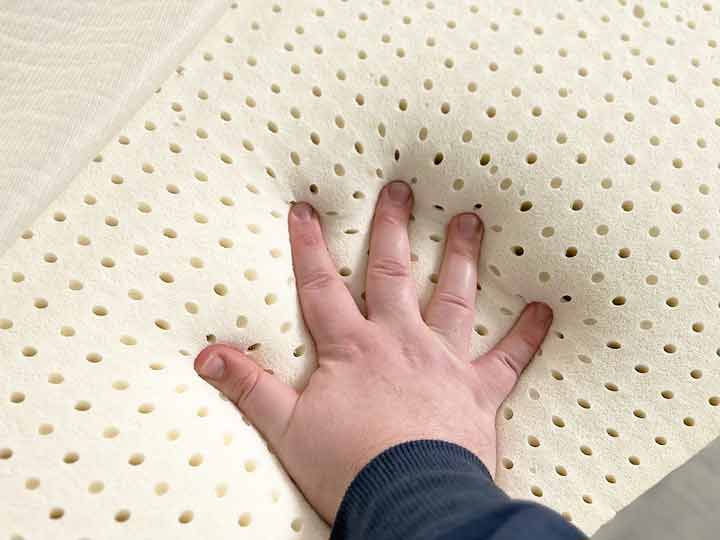
Wool
Wool and other natural fibers, like cotton, cashmere, silk, hemp, horsehair or alpaca, are also used in comfort layers. Depending on their density, they can add plushness or firmness, and they add breathability and durability to a mattress. Wool in particular is a natural flame retardant, which is a bonus if you’re trying to minimize your exposure to certain chemicals.
| Memory Foam | Latex | Wool | |
| Mattress Price Range | $-$$$ | $$$-$$$$ | $$$ |
| Availability | High | High | Less common |
| Durability | Good | Great | Very good |
| Pressure Relief | Excellent | Excellent | Good |
| Motion Isolation | Excellent | Fair | Good |
| Cooling | Fair | Excellent | Very good |
Transition Layers
Transition layers are generally made of polyfoam, latex, memory foam, or microcoils. The purpose of this layer is to separate the comfort materials from the support materials, and serve as a barrier that prevents the body from sinking beyond the comfort layers into the firmer layers below. Transition layers also boost durability and stability in a mattress.
Mattress Support Layers
Support layers are found at the base of the mattress. They offer lumbar support and help prevent people from “bottoming out” on the mattress. Here’s a closer look at the different types of materials you may find in a mattress’s support layer.
Innersprings
Innerspring coils are made from steel and serve several purposes. In addition to stabilizing the mattress, coils add a bit of bounce and breathability. They also come in a few different types. Encased or pocketed coils are individually wrapped in fabric, which means each coil functions independently to offer targeted support, pressure relief, and motion isolation. It also makes them quieter. Some coils are continuous and created from a single long wire. That improves durability, but this coil construction often lacks pressure relief and motion isolation.
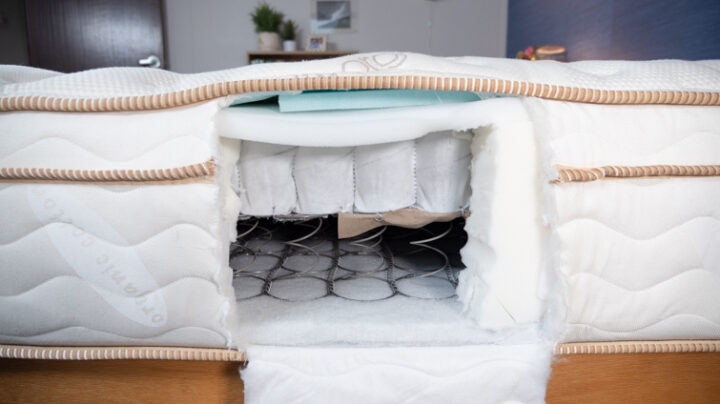
High-Density Foam
High-density foam is a firm foam that’s often made of polyurethane. It adds durability and support to a mattress and helps ensure proper spinal alignment. High-density foam is occasionally used in comfort layers in lower quality mattresses, but it can trap heat, so it’s best used in a support layer.
Latex
Some mattresses are made entirely of latex foam. Softer latex foam is used in the comfort layers, while firmer, denser latex layers make up the support layers.
Mattress Constructions
All mattresses have a cover and a combination of comfort and support layers, but mattress construction can vary.
All-Foam
All-foam mattresses can contain polyfoam, memory foam, and latex foam to deliver both comfort and support. There are no coils of any kind in this kind of mattress. Depending on the materials used, all-foam mattresses may be prone to trap heat. They can also be less durable than those made with coils, and they may lack edge support, too.
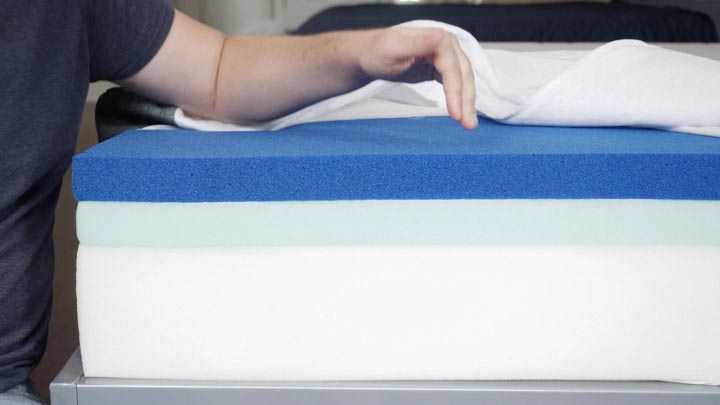
Hybrid
Hybrid mattresses combine different types of foam in the comfort layer with a layer of coils. This improves airflow and adds more durability. Hybrid mattresses with reinforced perimeters also offer excellent edge support.
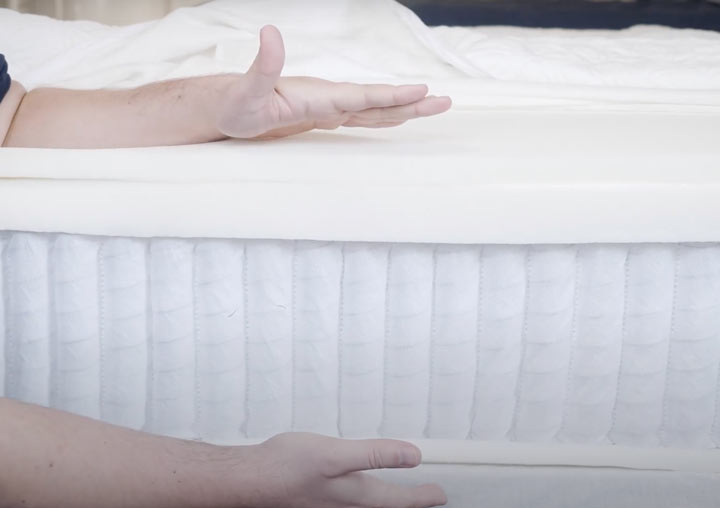
Innerspring
Innerspring mattresses are comparable to hybrid mattresses, in that they combine foam comfort layers with coils for support. But the ratio of comfort materials to coils is different. Innerspring mattresses have a much thinner layer. Most modern innerspring mattresses are actually hybrids these days.
Flippable
Flippable mattresses may have an all-foam or hybrid construction, but they’re designed without a definitive top and bottom. Instead, the support layers are situated in the center of the mattress, with comfort layers on either side. Often, these layers have a different firmness. The flippable design means you can sleep on either side, depending on your preference.
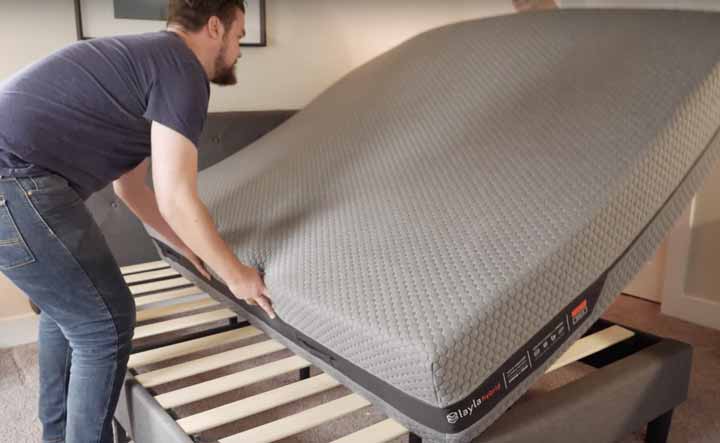
Dual-Firmness
Dual-firmness mattresses are built with different firmness levels on either side of the bed. They can be all-foam or hybrid mattresses, and they work well for partners who share a bed but have different firmness preferences. Dual-firmness mattresses may use different materials to achieve their varying firmness options, but some, like the Saatva Solaire, are made with air chambers that can be independently inflated and deflated to meet individual needs.
How Thick Should Your Mattress Be?
Mattress depth can vary. Low-profile mattresses are generally 5”- 8” tall. Standard mattresses are between 8” and 12”, while thicker mattresses measure between 12” and 16”. Anything over 16” is considered an extra thick mattress.
The best option comes down to personal needs. Thicker mattresses are generally associated with luxury, but factors like body type, sleep style, age, and whether or not you share your mattress with a partner can all dictate the most appropriate mattress height for you. Kids, for example, should have thinner mattresses for safety reasons. Adults with certain conditions, like sciatica, may do better on a thicker mattress. People with bigger bodies also benefit from a thicker mattress to ensure they’re getting enough support.
What is Needed to Support a Mattress?
To ensure your mattress performs as its best, it needs proper support of its own. In fact, some mattress companies will void a warranty if you don’t use the appropriate foundation or base. Here are the most common options:
- Box Spring. Box springs are frames filled with a layer of springs and covered with a thin layer of fabric. They go beneath the mattress to keep it elevated on a frame, and they help absorb impact from your body weight. Box springs can also prolong mattress life.
- Foundation. A foundation is similar to a box spring, but the frame has slats instead of springs. Like box springs, foundations are usually wrapped in a light fabric.
- Slatted Base. These are made with planks of wood that sit horizontally on a bed frame to support your mattress. Because they aren’t solid, but rather slightly spaced apart, they don’t change the feel of a mattress. Slatted bases can also improve breathability.
- Bed Frame. A bed frame is an elevated platform that keeps the mattress and its base off the ground. They come in myriad designs to suit different styles.
- Adjustable Base. An adjustable base can be adjusted to tilt the head or foot of a bed using a remote control. These can be helpful for people with sleep apnea, acid reflux, or injuries.
FAQs
How many layers should a mattress have?
The number of layers can vary, but a mattress should have at least one support layer, one comfort layer, and a mattress cover. More layers may be included to add additional benefits.
Which support layer is best for a mattress?
The materials used in a support layer can vary, and so can their benefits and drawbacks. High-density foam can be inexpensive, but it often traps heat and lacks the durability of coils. Coils are breathable and responsive, but in time, they can become noisy.
What is the difference between a support layer and a comfort layer?
Support layers are designed to maintain spine alignment and add structure to a mattress. Comfort layers give a mattress its firmness and feel, along with benefits like pressure relief and motion isolation.


